
Huntsman spiders, members of the family Sparassidae, are known by this name because of their speed and mode of hunting. They are also called giant crab spiders because of their size and appearance. Larger species sometimes are referred to as wood spiders, because of their preference for woody places. In southern Africa the genus Palystes are known as rain spiders or lizard-eating spiders. Commonly they are confused with baboon spiders from the Mygalomorphae infraorder, which are not closely related.
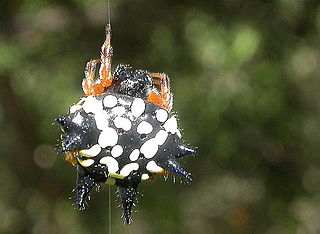
Austracantha is a genus of spider with a single species, Austracantha minax, commonly known as the jewel spider or the Christmas spider. It is a member of the family Araneidae and is endemic to Australia. They are relatively small spiders, reaching a maximum total body length of only around 12 mm (0.47 in) for females, and 5 mm (0.20 in) for males. Their abdomen has six distinctive projections ("spines") that makes them easy to identify. They are predominantly a shiny black, with variable white, yellow, and orange patterns. Melanistic forms also occur during autumn. They are facultatively gregarious, and can be found in large aggregations of overlapping orb webs. They feed on small flying insects that get entangled in their webs. They are harmless to humans, though the webs can be a nuisance for bushwalkers. They are most abundant during the summer months.

The black house spider or common black spider is a common species of cribellate Australian spider, introduced to New Zealand and Japan. A closely related species, Badumna longinqua, the grey house spider, has a similar distribution, but has also been introduced to the Americas.

Deinopis subrufa is a species of net-casting spiders. It occurs in Australia and in New Zealand. It is a nocturnal hunter, having excellent eyesight, and hunts using a silken net to capture its prey. They feed on a variety of insects – ants, beetles, crickets and other spiders. They can vary in color from fawn to pinkish brown or chocolate brown. Females are about 25 mm in body length, males about 22 mm. They are not dangerous to humans.
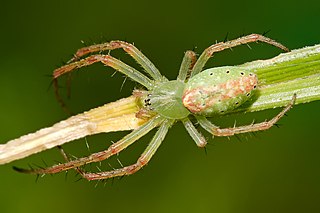
Cyrtophora, the tent-web spiders, is a genus of orb-weaver spiders first described by Eugène Simon in 1895. Although they are in the "orb weaver" family, they do not build orb webs. Their tent-like, highly complex non-sticky web is sometimes considered a precursor of the simplified orb web. These webs are aligned horizontally, with a network of supporting threads above them. These spiders often live in colonies. Females have a body length of mostly about 10 millimetres (0.39 in) long. Some members, including Cyrtophora cicatrosa, exhibit the ability to change colour rapidly.

Sidymella rubrosignata is a species of crab spiders found in Australia. It is a common spider, often seen on Dianella plants.

Cyrtophora citricola, also known as the tropical tent-web spider, is an orb-weaver spider in the family Araneidae. It is found in Asia, Africa, Australia, Costa Rica, Hispaniola, Colombia, and Southern Europe. In 2000, it was discovered in Florida.

Polycalymma stuartii, the poached egg daisy, is an Australian daisy found abundantly on sand plains and dunefields. Its common name is derived from the poached egg-like appearance of its white flower and yellow centre. It is the only known species of the genus Polycalymma; a member of the pussy's-toes tribe within the daisy family.

Cyrtophora exanthematica are tent spiders common in tropical Asia and Australia. They are commonly known as double-tailed tent spiders because of the pair of blunt projections at the end of their abdomens. They are harmless to humans.
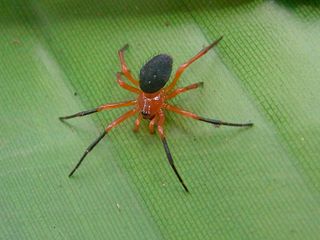
Nicodamus peregrinus, known as the red and black spider, is a common spider found in eastern and southern Australia. Unlike with the redback spider, the bright red coloration does not appear to warn of significant danger to humans. Food is a variety of small insects. They have been recorded in Queensland, New South Wales, Victoria, Tasmania and South Australia.

Araneus praesignis is a species of orb-weaving spider found in Queensland, Australia where it is widespread and common in well-vegetated areas. The Atlas of Living Australia shows a record from New South Wales. In 2015 a sighting from China was reported. It has bold black blobs on its rear, perhaps mimicking eyes. In 2014 Carly Brooke Martinetti gave it the common name "Alien Butt Spider" by which it became internationally known. Due to its memorable common name and strange appearance photographs of the spider have appeared in many online blogs and galleries.

Argyrodes antipodianus, also known as the dew drop spider, is a species of kleptoparasitic spider from the cobweb spider family found in Australia, New Zealand and New Caledonia.

Thomisus spectabilis, also known as the white crab spider or Australian crab spider, is a small spider found in Australia and far east Asia.
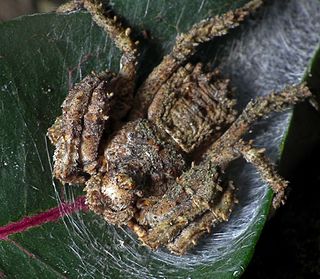
Stephanopis altifrons is a crab spider found in Australia. A cryptic species often hidden on bark of a tree. The body length of the female is up to 10 mm, the male 6 mm. The colour is usually brown, or shades of grey, sometimes black. The egg sac is 7.5 mm in diameter. Often placed in a crevice in tree bark; irregular in shape and camouflaged with debris. Eggs are off white in colour, 25 to 30 in number. The female rests with the eggs. The food of this spider is appears to be other spiders. Recorded prey include spiders in the families Salticidae and Hersiliidae.

Euryopis splendens is a species of comb-footed spider in the family Theridiidae. The range of distribution is the south east of Australia. The spider lives under stones or bark.

Australomisidia cruentata, one of the crab spiders, is a small spider found in Australia. The body length of the female is up to 5 mm, the male 3 mm. An ambush predator, often seen on flowers in the Pultenaea group of egg and bacon plants, belonging to the pea family. The egg sac is also laid on the flowers. Petals being fastened with silk in a chamber. The spider stays with the eggs, probably still hunting from the entrance of the retreat, with the egg sac nearby. Prey is small flying insects. The genus Australomisidia was created in 2014, the word being a combination of Australia and Thomisidae, the crab spiders.
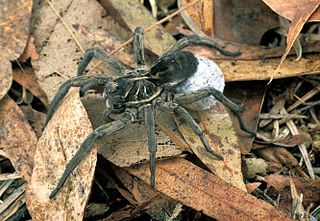
Tasmanicosa godeffroyi, one of the wolf spiders, is a mid sized spider found in all states of Australia. Perhaps the most commonly noticed of the wolf spiders in Australia. Variable in pattern and colour, though the underside of the abdomen is black. Wolf spiders tend to rest at the entrance of their burrows, and their eyes reflect the light of passing cars or torchlight. The burrow has a thin veil of silk, without a lid, unlike some other wolf spiders. The burrow is circular in cross section, it travels down for around 15 cm, then parallel with the ground for the next 15 cm. The body length of the female is up to 27 mm, the male 25 mm.

Venatrix furcillata, one of the wolf spiders, is a mid sized spider found in eastern Australia. The body length of the female is up to 13 mm, the male 9 mm. The abdomen has distinctive tapering markings. Sometimes noted in suburban gardens and lawns. It lives in a simple burrow, but may be seen migrating in large numbers to a communal web, an unusual feature for wolf spiders. The grey coloured spherical egg sac is around 6 mm in diameter, carried by the female. Eggs are 45 to 60 in number, 0.8 mm in diameter. Prey is ground dwelling insects. The spider has been identified as occurring in Queensland, New South Wales, and Victoria.
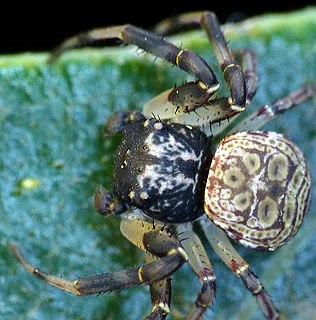
Cymbacha saucia is a crab spider found in Australia. The body length of the female is up to 7 mm, the male 4 mm. A cryptic small species, the colour is usually brown, grey and black. Often found in a folded leaf, used as a retreat.

Arbanitis robertsi is a species of tube spider in the family Idiopidae found in and near rainforests in New South Wales and Queensland, Australia. A mid to large sized spider which builds a tube of web that extends from the burrow. The tube is attached to rocks, tree ferns or the base of trees. Thousands of these tubes were recorded by Sid Jackson in November 1922 at the south eastern end of Wallis Lake. "Up to three feet long, and half an inch wide". Situated on damp ground, close to freshwater streams.




















